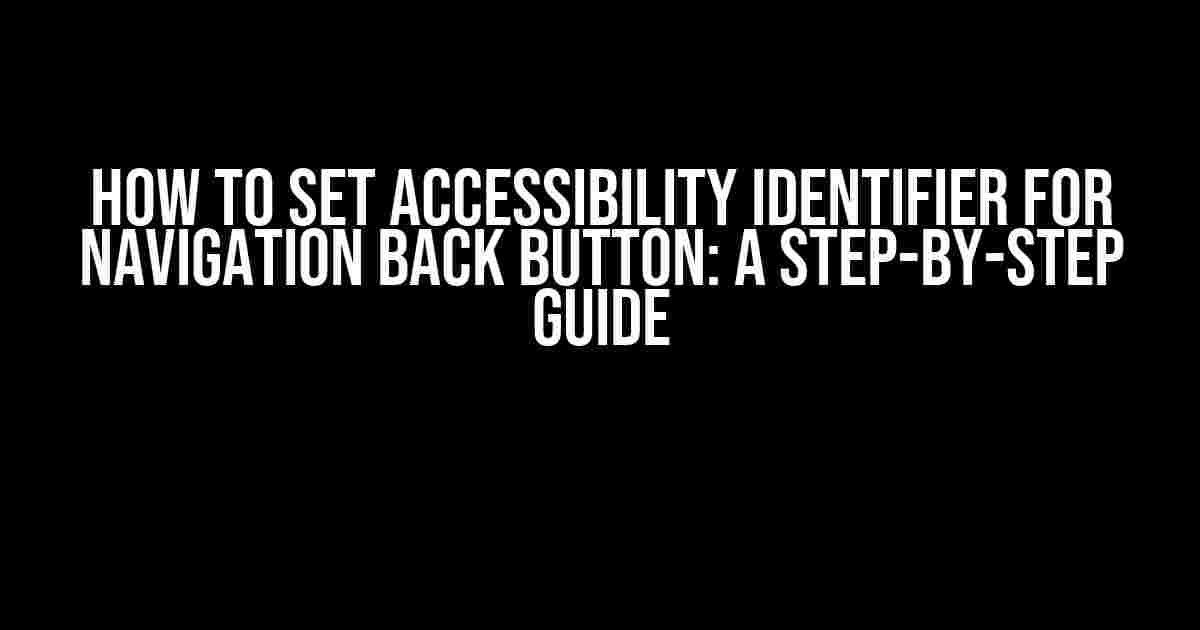Are you tired of users struggling to navigate through your app? Do you want to make your app more accessible to users with disabilities? Setting an accessibility identifier for your navigation back button is a crucial step in ensuring that your app is user-friendly and accessible to everyone. In this article, we’ll take you through a comprehensive guide on how to set accessibility identifier for navigation back button, so you can make your app more accessible and usable.
What is an Accessibility Identifier?
An accessibility identifier is a unique identifier that helps assistive technologies, such as screen readers, to identify and interact with UI elements in your app. It’s a vital component of making your app accessible to users with disabilities, as it enables them to navigate and interact with your app using assistive technologies.
Why is it Important to Set Accessibility Identifier for Navigation Back Button?
The navigation back button is a critical element in your app’s navigation system. It allows users to go back to the previous screen or page. However, for users with disabilities, the navigation back button can be a significant barrier if it’s not accessible. By setting an accessibility identifier for the navigation back button, you can ensure that:
- Screen readers can read out the button’s label and purpose, enabling users with visual impairments to navigate through your app.
- Users with motor disabilities can activate the button using assistive technologies, such as voice commands or switches.
- Users with cognitive disabilities can understand the button’s purpose and function, reducing confusion and frustration.
Step-by-Step Guide to Setting Accessibility Identifier for Navigation Back Button
Now that you understand the importance of setting an accessibility identifier for the navigation back button, let’s dive into the step-by-step guide on how to do it:
Step 1: Identify the Navigation Back Button Element
In your app’s code, identify the navigation back button element. This could be a Button or ImageButton element, depending on your app’s architecture.
<Button android:id="@+id/back_button" android:layout_width="wrap_content" android:layout_height="wrap_content" android:text="Back" />
Step 2: Add the Accessibility Identifier
Add the android:accessibilityIdentifier attribute to the navigation back button element. This attribute takes a unique string value that identifies the element.
<Button android:id="@+id/back_button" android:layout_width="wrap_content" android:layout_height="wrap_content" android:text="Back" android:accessibilityIdentifier="back_button_identifier" />
Step 3: Define the Accessibility Identifier in Strings.xml
In your app’s strings.xml file, define a string resource for the accessibility identifier. This string resource should describe the purpose and function of the navigation back button.
<resources> <string name="back_button_identifier">Go back to previous screen</string> </resources>
Step 4: Test the Accessibility Identifier
Test the accessibility identifier by running your app on an emulator or physical device with TalkBack or VoiceOver enabled. Navigate to the screen that contains the navigation back button and listen to how the screen reader announces the button’s label and purpose.
Best Practices for Setting Accessibility Identifier for Navigation Back Button
Here are some best practices to keep in mind when setting an accessibility identifier for the navigation back button:
| Best Practice | Description |
|---|---|
| Use a unique identifier | Use a unique string value for the accessibility identifier to avoid conflicts with other elements. |
| Keep it concise | Keep the accessibility identifier concise and descriptive, avoiding lengthy descriptions. |
| Use a consistent naming convention | Use a consistent naming convention for accessibility identifiers throughout your app. |
| Test thoroughly | Test the accessibility identifier on different devices and platforms to ensure it’s working as expected. |
Common Mistakes to Avoid
Here are some common mistakes to avoid when setting an accessibility identifier for the navigation back button:
- Not setting an accessibility identifier at all: This is the most critical mistake, as it prevents assistive technologies from identifying and interacting with the navigation back button.
- Using a generic identifier: Using a generic identifier, such as “button” or “back”, can lead to confusion and make it difficult for users to understand the button’s purpose.
- Not testing the accessibility identifier: Failing to test the accessibility identifier can lead to unexpected behavior or conflicts with other elements.
Conclusion
Setting an accessibility identifier for the navigation back button is a critical step in making your app more accessible and usable. By following the steps outlined in this article, you can ensure that your app is more inclusive and user-friendly for users with disabilities. Remember to test your app thoroughly and avoid common mistakes to ensure that your app provides an exceptional user experience for all users.
By making your app more accessible, you can:
- Increase user engagement and satisfaction
- Improve your app’s overall usability
- Comply with accessibility guidelines and regulations
- Enhance your app’s reputation and brand
So, what are you waiting for? Take the first step towards making your app more accessible and usable today!
Here are 5 Questions and Answers about “How to set accessibility identifier for navigation back button?”
Frequently Asked Question
Get answers to the most common questions about setting accessibility identifiers for navigation back buttons!
What is an accessibility identifier for a navigation back button?
An accessibility identifier, also known as an accessibility ID, is a unique string that helps identify a user interface element, such as a navigation back button, for accessibility testing and automation purposes. It enables you to locate the element and interact with it programmatically, ensuring that your app is accessible to users with disabilities.
Why is it important to set an accessibility identifier for a navigation back button?
Setting an accessibility identifier for a navigation back button is crucial because it allows users with disabilities to navigate your app using assistive technologies, such as screen readers. Without an accessibility identifier, these users may not be able to interact with the back button, limiting their ability to use your app.
How do I set an accessibility identifier for a navigation back button in iOS?
In iOS, you can set an accessibility identifier for a navigation back button using the `accessibilityIdentifier` property in Swift or Objective-C. For example, `myBackButton.accessibilityIdentifier = “backButton”`.
How do I set an accessibility identifier for a navigation back button in Android?
In Android, you can set an accessibility identifier for a navigation back button using the `android:contentDescription` attribute in your layout XML file. For example, ``.
Can I use the same accessibility identifier for multiple navigation back buttons in my app?
No, it’s not recommended to use the same accessibility identifier for multiple navigation back buttons. Each accessibility identifier should be unique to ensure that assistive technologies can accurately identify and interact with the correct element. Using the same identifier for multiple elements can cause confusion and make it difficult for users with disabilities to navigate your app.


